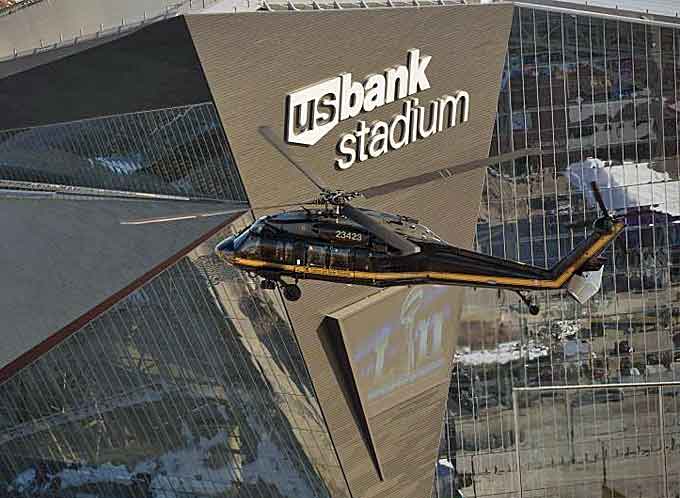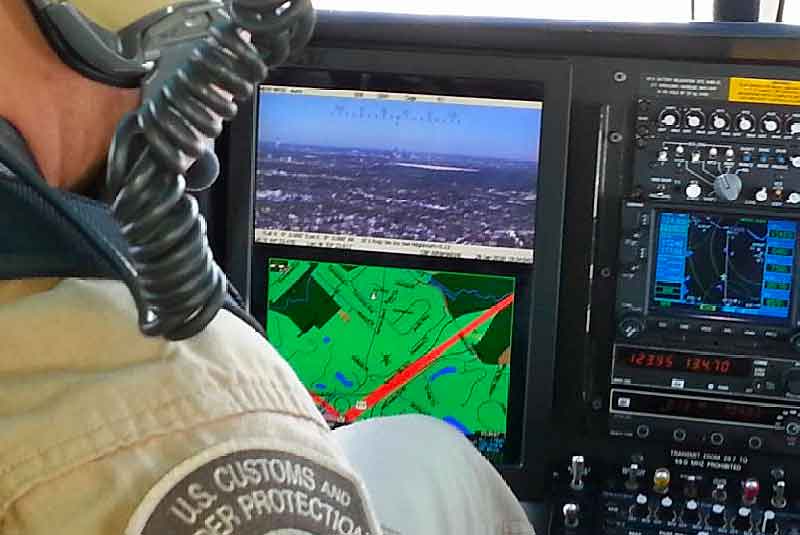
It’s a perfect day, bright blue sky above, and temperatures just a degree or two above zero.
It’s cold but business as usual for U.S. Customs and Border Protection (CBP), Air and Marine Operations (AMO) helicopter crews flying security missions at this year’s Super Bowl in Minneapolis, Minnesota.
“The other bird is at your 8 o’clock and close,” said the sensor operator in the AS350, better known as the AStar helicopter making circles around the stadium in the downtown area of the northern city.
A quick acknowledgement by the pilot – “Got it” – confirms everyone has situational awareness of everything going on above and below the helicopter crews patrolling the area.
(See a short overview of CBP security operations in support of Super Bowl LII and features CBP PAO Kris Grogan interviewing CBP Lead Field Coordinator CPA Douglas Harrison. Courtesy of U.S. Customs and Border Protection and YouTube. Posted on Jan 29, 2018)
About 65 AMO personnel and six aircraft – three UH-60 Black Hawk and three AStar helicopters – are working the Super Bowl this year.
They’re part of a larger 150-plus force of AMO agents and officers, Border Patrol agents, CBP officers, import specialists and others from CBP locations all around the country.
In the air, AMO has two main missions: be the eyes in the sky and help keep the air space around the stadium safe.
“We’re providing an aerial downlink with cameras mounted on our birds feeding live video back to the joint operations centers back on the ground, as well as providing that extra level of air security,” said Jonathan Johnson, a supervisory air interdiction agent at a small airport just a few minutes flying time from downtown Minneapolis.
“The people back on the ground can ask for our AStar operators to provide video of a particular part of the city. We can check out a suspicious vehicle or people and eliminate any questions of what’s happening on the ground.”
(U.S. Customs and Border Protection PAO Kris Grogan takes you for a ride along in a UH-60 Black Hawk for a birds-eye view of U.S. Bank Stadium as Minneapolis prepares to host Super Bowl LII. Courtesy of U.S. Customs and Border Protection and YouTube. Posted on Jan 30, 2018)
AMO has been in the area for about a week and a half before Super Bowl Sunday, patrolling the area.
On game day, the Black Hawk crews will assist National Guard F-16 fighter aircraft, detecting, tracking and coordinating the interdiction of aircraft violating a temporary no-fly zone for miles around the stadium.
If any aircraft violate that air space, CBP will intercept and determine if more law enforcement is needed.

The coordination between CBP, the Department of Defense, other federal assets and local law enforcement has been in the works for more than a year.
“This is a large puzzle with a lot of moving parts,” said Johnson.
And before the helicopters took off on this particularly cold day, maintenance crews made sure they were in tip-top condition.
“We need to keep these birds flying,” said Matt Swazey, a contract aircraft mechanic from Detroit.
“We’re keeping them safe, because our aircrews have an important mission to support. And we’re here to support them.”
Shrugging off the bitter chill in the air, the pilots and crews mount up for another patrol over the frozen city along the icy banks of the Mississippi River.

While in the air, the AStar pilot takes a few minutes to brief his sensor operator on some of the emergency landing zones in and around downtown Minneapolis, pointing out helipads and empty lots where they could put down in a hurry if the unthinkable happened, in addition to local hospitals.
It’s just part of making sure everyone is prepared for the unexpected and a tribute to the professionalism AMO crews are bringing to Super Bowl LII.
“Our air crews have a lot of fun and are good at what they do,” added Johnson.
“We have the most experienced and professional folks in the air serving the American public.”
CBP Screens Vehicles at Super Bowl
Additionally, as thousands of vehicles bring in the food, souvenirs, high-definition television equipment and fans to celebrate this year’s Super Bowl in Minneapolis, Minnesota, CBP is making sure no one – and no thing – comes in that’s not supposed to.
“We scan vehicles coming in for explosives, weapons and anything that might look out of place,’” said James Askin, a CBP officer from the Port of Newark, New Jersey, working as a non-intrusive inspection equipment operator in the back of a giant X-ray truck under a tent at the Minnesota State Fairgrounds, just a few miles from the stadium.

vehicles destined for US Bank Stadium to deliver provisions & equipment for Super Bowl LII in Minneapolis. (Image courtesy of Glenn Fawcett)
“Nothing gets in without our thumbs-up.”
It’s a process made quicker and easier with CBP’s non-intrusive inspection equipment: The Vehicle and Cargo Inspection System, better known as VACIS, and the Z-Backscatter Van.
VACIS is a large X-ray machine for semitrailers while Backscatter is a smaller and more mobile version of the same technology to scan personal vehicles, delivery vans and recreational vehicles.
“These machines basically take an X-ray of a vehicle,” said Gerald Durand, a CBP watch commander at the Minneapolis Service Port.
“That saves us a great deal of time, allowing us to search each vehicle in just 7-10 minutes,” an important aspect when you consider the hundreds of vehicles that the port of entry checks every day.
(CBP PAO Kris Grogan interviews CBP Supervisory Office of Field Operations Officer Lee Takaki about CBP’s mission of protecting the public attending Super Bowl LII using non-intrusive inspection systems. Courtesy of U.S. Customs and Border Protection and YouTube. Posted on Jan 31, 2018)
VACIS scans both sides of large items, including semis and cargo containers and usually is used at ports of entry.
It’s able to detect anything from big, hidden compartments down to small packages or even something as small as a handgun. It even picks up people being smuggled in a trailer or vehicle.
Backscatter does basically the same thing, but fits in a box on the back of a truck and scans just one side of a vehicle.

It works well in the cold, an important factor considering the Super Bowl’s cold weather location this year.
Durand said both systems’ effectiveness is a reflection of the skills of their three to five-person crews of operators, drivers and guides.
“The operators and their experience – knowing what to look for and knowing what doesn’t look right – really makes the difference in identifying what’s in a shipment,” he said, adding that once some kind of anomaly is found, it’s up to CBP officers on the ground to dig in and find it.
On this day, Askin sees something that’s not quite right, just behind the cab of a tractor-trailor coming through.
It shows up on the screen in front of him as a dark anomaly. Askin has another member of the team check out the dark spot by digging into the actual spot on the vehicle.
This time, it turned out just to be some tools and a warning triangle the trucker carries with him for emergencies.

The trained eyes of the officers – made faster and more efficient by the high-tech equipment – provide a layer of defense that helps peel away the layers of cargo without spending hours digging into each and every vehicle, an unfeasible prospect considering the thousands of vehicles coming through.
“We’re trained to find anything out of the ordinary,” said Rose Wood, a supervisory CBP officer who’s trekked from the much warmer climate of El Paso, Texas, to a considerably colder Minneapolis.
“We and our equipment work in all weather.”
Another important part of the process is keeping the crews and public safe from the large doses of X-rays used to peer into the trucks, trailers and recreational vehicles coming through the screening process.
Mark Jadick, a CBP central team health physicist from Seattle, Washington, walked around the search site with a handheld piece of equipment called a GM probe to make sure no one is getting overdosed.

“We have well-established control boundaries set up in the tent,” he said.
“These operators are excellent and know what they are doing.”
“My job is to provide a final check before we get any operations going.”
“Everything is operating smoothly and safely, as it should be.”
In addition, Jadick carried another handheld device called a RadSeeker, which measures for any radiation coming from the cargo.
“If we pick up radiation after VACIS is off, RadSeeker can tell us why,” said Jadick.
Durand said for the dozens of CBP personnel operating the non-intrusive inspection equipment at the Super Bowl, it’s valuable experience.

“Any time they get to see anything different from their routine, it’s always going to help their abilities to do their jobs,” said Durand.
Once CBP has done its job, the vehicles are handed off to National Guard and law enforcement assets for escort to the stadium.
For Askin, the task at the Super Bowl in many ways is much like his regular job back at the Port of Newark.
But he said it’s a bit more challenging since, this time, they don’t have the typical manifests that usually accompany the cargo. But he credits his team members for making it all work.
(U.S. Customs and Border Protection PAO Kris Grogan opens a box and finds a surprise as Minneapolis prepares to host Super Bowl LII. Courtesy of U.S. Customs and Border Protection and YouTube. Posted on Feb 1, 2018)
“CBP Officer Gilbert Longoria, the VACIS driver, is from Houston; I’m from Newark. I just met him two days ago, but we’re already on the same page,” said Askin.
“We’ve got guys from all over the country, but everyone knows what they’re doing. It really shows a good aspect of CBP teamwork.”

















